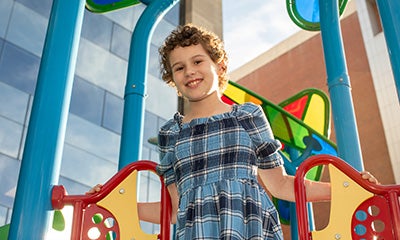Anne Phillips Arrington
February 19, 2025Osteosarcoma of the distal femur in right leg
When McMillan and Morgan Arrington received the results of their daughter's X-ray on March 31, 2023, they were stunned. After experiencing knee pain that kept her from sleep, Anne Phillips Arrington had seen her pediatrician. Because she was active and athletic, her parents and pediatrician expected the X-ray to show a sports-related injury. They had not made it home before they got the call from their pediatrician asking them to return. They went home on a Friday evening with the news that Anne Phillips likely had cancer.
Two weeks before her eighth birthday, Anne Phillips was diagnosed with osteosarcoma of the distal femur in her right leg. After receiving the news from Anne Phillips’ orthopedist, her parents were faced with having to tell their 7-year-old daughter the life-changing news. They were amazed by the thoughtful questions she had and the bravery she possessed. She requested to be present from then on when her parents met with her doctors.
It was an agonizing and painful 30 days from the time they got the diagnosis to when they started treatment. However, this period gave them the time to arm themselves with research. They learned about the MAP treatment for childhood osteosarcoma and that Anne Phillips could receive top-notch treatment at Children’s of Alabama. “We realized we were going to be able to be in-state and use our network of family and friends. It's scary to learn that your child needs treatment, but it was nice to learn that it existed right up the road,” Morgan said.
At the beginning of May, Anne Phillips started her 30-week treatment plan. One week into treatment, Dr. Lisa Kafchinski shared surgical options to remove the cancer from her femur. “I think one of the hardest parts for us was having to pick the surgery,” McMillan said. “We were trying to make decisions about her body that will impact her for the rest of her life.” The family was presented with three options to remove the cancerous bone:
- Full-leg amputation
- Limb salvage surgery: This option requires a full internal knee replacement. The surgeon then takes out all the infected bones and replaces them with magnetic rods that grow up to three centimeters.
- Rotationplasty: A rotationplasty involves removing of the cancerous bone, then rotating the remaining healthy portion of the limb to create a new and functional joint.
McMillan and Morgan honored Anne Phillips’ wishes and presented her with the surgical options and limitations that come with them. A rotationplasty would change the appearance of her leg drastically, but Anne Phillips was considered young for limb-salvage surgery. She had plenty of growing left to do, and that option would stunt the affected limb's growth and leave her unable to participate in her favorite hobbies and sports. She would be unable to run, ride horses, or climb trees. With tears in her eyes, Anne Phillips made her decision. She told her parents, “I want to climb a tree, and I want to do the surgery that will let me do that.” She had her rotationplasty on July 20th in Salt Lake City, Utah.
Anne Philips’s leg was amputated, and the femur was removed. Surgeons then rotated the remainder of the limb 180 degrees and reattached her tibia to the where the femur once was, allowing her ankle to function as her knee would. “When they first explained the rotationplasty, I immediately said no,” Mcmillan shared. “But once we did more research, we realized what a beautiful and incredible surgery it is.”
Anne Phillips returned to Alabama and resumed treatments in September. On December 23rd, the Arringtons received the best Christmas present yet. Anne Phillips finished her last drug and was discharged from the hospital around 11:00 that night. “It was such a blessing to actually be in our home with our family for Christmas,” Morgan said.
Throughout their hard and heavy experience, the Arringtons still found moments of joy and resilience. “You get so much generosity and so much kindness that you experience these weird highs and shiny, happy moments,” McMillan said. “All of the nurses have this ability to make you feel like the greatest person there, like you’re the only patient.” One of these moments was thanks to child life specialist Marry Haddow.
During treatment, Anne Phillips was set to be the 13th girl in her family to attend Camp Desoto. On what was supposed to be her first opening day of camp, she was in the hospital. Mary, a former Camp Desoto camper, decided to arrange something special. “We went to drop off our older daughter at camp,” Morgan said, “and came back to find that Mary Haddow has given Anne Phillips her own opening day of camp. She included all of the camp’s opening day traditions.” The following summer, Anne Phillips was able to attend her first year at camp, where Mary showed up as a volunteer and checked on her favorite camper.
Attending camp is only one of Anne Phillips’s many achievements since finishing her treatment. Her first prosthetic leg had little flexibility, but that didn’t stop her. “This little girl is determined and is not going to listen to anybody about any potential limitations,” McMillan shared. “She breezed past her first prosthetic leg and was determined to run.” Now in fourth grade, Anne Phillips has now completed two 5K races. She has plans to grow as an athlete and is currently playing basketball. “I think that that's just a strong testament to who Anne Phillips is and to this being the right surgery for her,” her parents said. “She wants to move forward and just be active. Of course, there have been moments of her feeling down, as she’s entitled to. But that is not her identity.”














